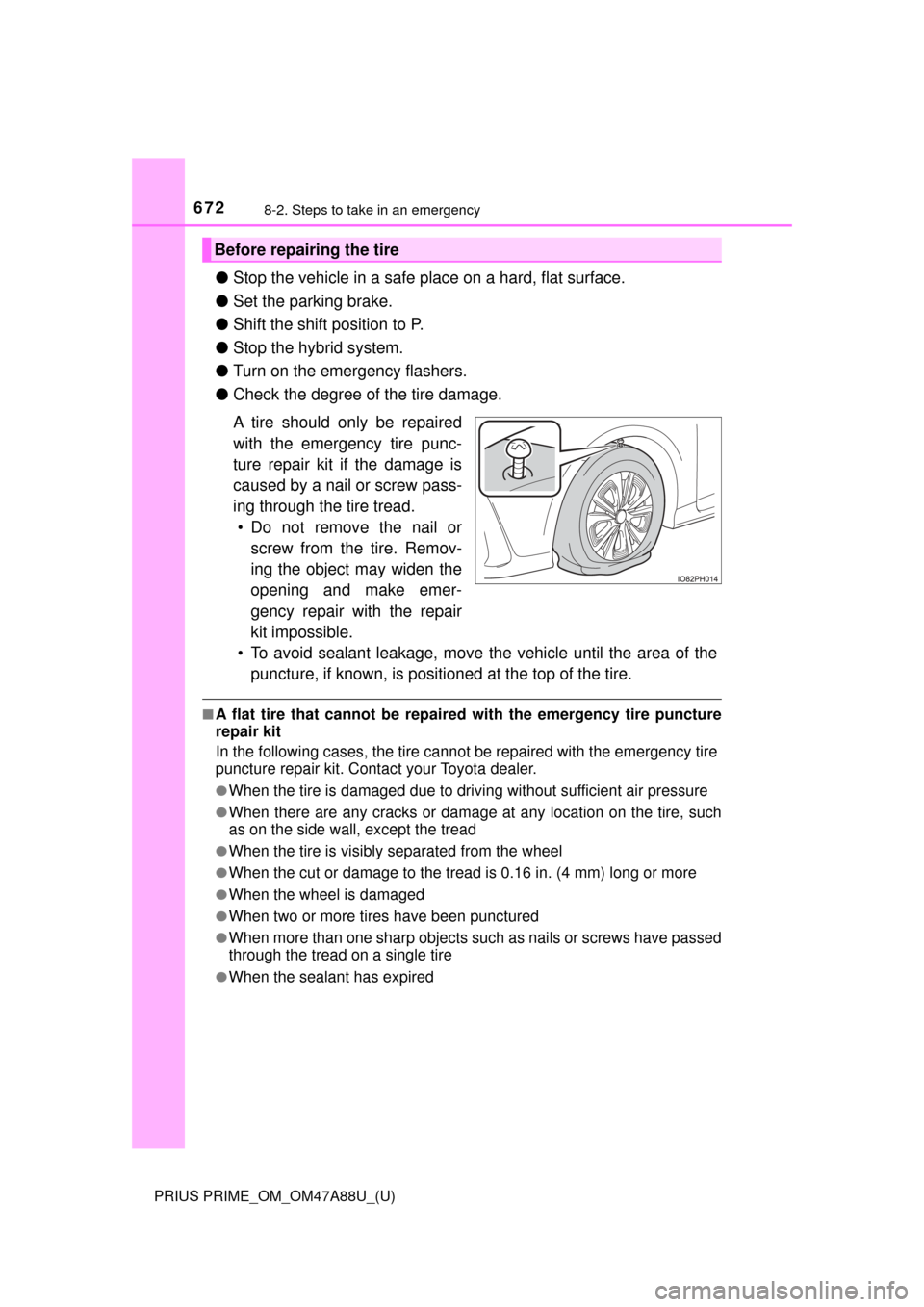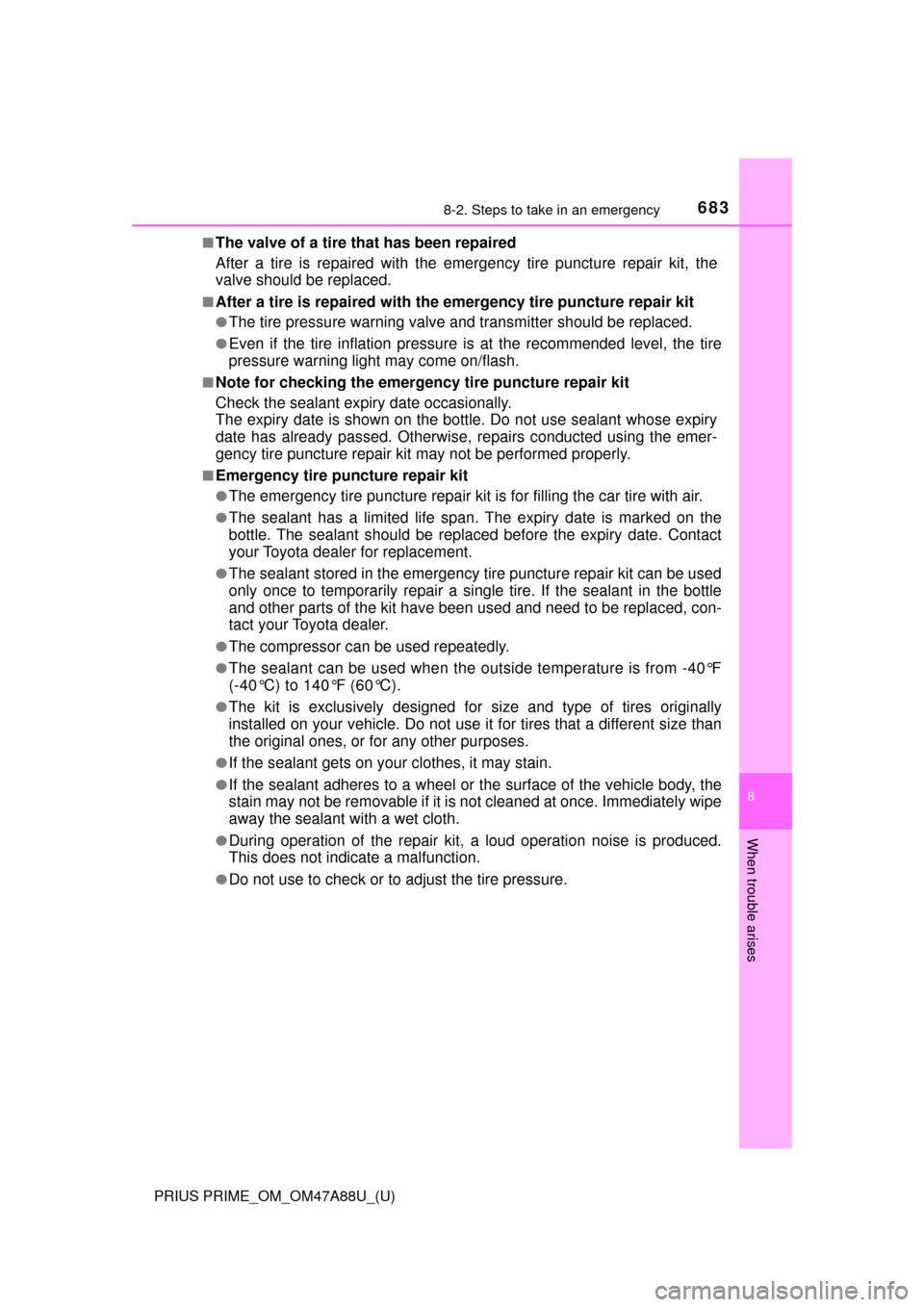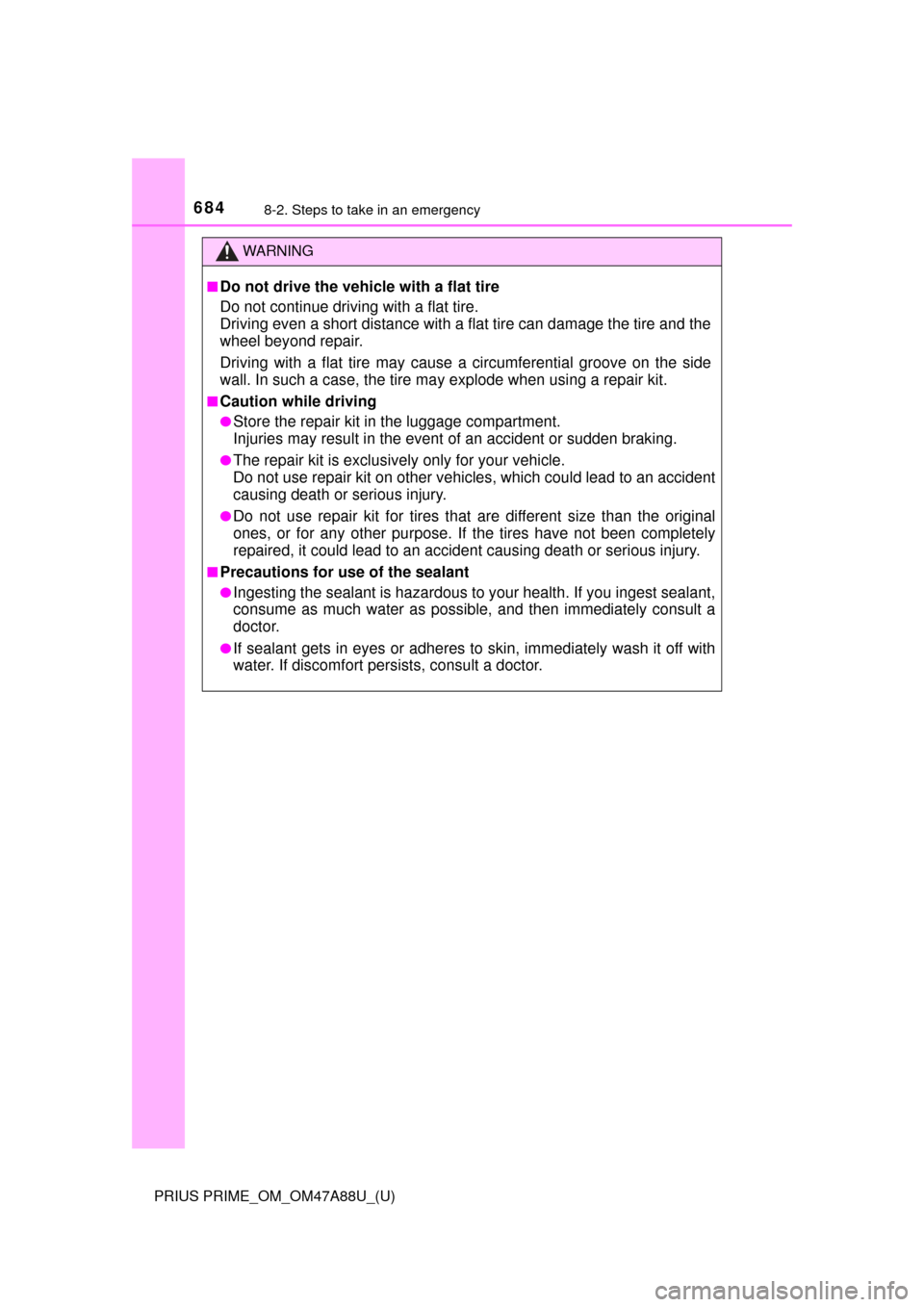Page 672 of 784

6728-2. Steps to take in an emergency
PRIUS PRIME_OM_OM47A88U_(U)
●Stop the vehicle in a safe pl ace on a hard, flat surface.
● Set the parking brake.
● Shift the shift position to P.
● Stop the hybrid system.
● Turn on the emergency flashers.
● Check the degree of the tire damage.
A tire should only be repaired
with the emergency tire punc-
ture repair kit if the damage is
caused by a nail or screw pass-
ing through the tire tread.
• Do not remove the nail or screw from the tire. Remov-
ing the object may widen the
opening and make emer-
gency repair with the repair
kit impossible.
• To avoid sealant leakage, move the vehicle until the area of the
puncture, if known, is positi oned at the top of the tire.
■A flat tire that cannot be repaired with the emergency tire puncture
repair kit
In the following cases, the tire cannot be repaired with the emergency tire
puncture repair kit. Contact your Toyota dealer.
●When the tire is damaged due to driv ing without sufficient air pressure
●When there are any cracks or damage at any location on the tire, such
as on the side wall, except the tread
●When the tire is visibly separated from the wheel
●When the cut or damage to the tread is 0.16 in. (4 mm) long or more
●When the wheel is damaged
●When two or more tires have been punctured
●When more than one sharp objects su ch as nails or screws have passed
through the tread on a single tire
●When the sealant has expired
Before repairing the tire
Page 683 of 784

6838-2. Steps to take in an emergency
PRIUS PRIME_OM_OM47A88U_(U)
8
When trouble arises
■The valve of a tire that has been repaired
After a tire is repaired with the emergency tire puncture repair kit, the
valve should be replaced.
■After a tire is repaired with the emergency tire puncture repair kit
●The tire pressure warning valve and transmitter should be replaced.
●Even if the tire inflation pressure is at the recommended level, the tire
pressure warning light may come on/flash.
■Note for checking the emergency tire puncture repair kit
Check the sealant expiry date occasionally.
The expiry date is shown on the bottle. Do not use sealant whose expiry
date has already passed. Otherwise, repairs conducted using the emer-
gency tire puncture repair kit may not be performed properly.
■Emergency tire puncture repair kit
●The emergency tire punctu re repair kit is for filling the car tire with air.
●The sealant has a limited life span. The expiry date is marked on the
bottle. The sealant should be replaced before the expiry date. Contact
your Toyota dealer for replacement.
●The sealant stored in the emergency ti re puncture repair kit can be used
only once to temporarily repair a single tire. If the sealant in the bottle
and other parts of the kit have been used and need to be replaced, con-
tact your Toyota dealer.
●The compressor can be used repeatedly.
●The sealant can be used when the outside temperature is from -40°F
(-40°C) to 140°F (60°C).
●The kit is exclusively designed for size and type of tires originally
installed on your vehicle. Do not use it for tires that a different size than
the original ones, or for any other purposes.
●If the sealant gets on your clothes, it may stain.
●If the sealant adheres to a wheel or the surface of the vehicle body, the
stain may not be removable if it is not cleaned at once. Immediately wipe
away the sealant with a wet cloth.
●During operation of the repair kit, a loud operation noise is produced.
This does not indicate a malfunction.
●Do not use to check or to adjust the tire pressure.
Page 684 of 784

6848-2. Steps to take in an emergency
PRIUS PRIME_OM_OM47A88U_(U)
WARNING
■Do not drive the vehicle with a flat tire
Do not continue driving with a flat tire.
Driving even a short distance with a flat tire can damage the tire and the
wheel beyond repair.
Driving with a flat tire may cause a circumferential groove on the side
wall. In such a case, the tire ma y explode when using a repair kit.
■Caution while driving
●Store the repair kit in the luggage compartment.
Injuries may result in the event of an accident or sudden braking.
●The repair kit is exclusively only for your vehicle.
Do not use repair kit on other vehicles, which could lead to an accident
causing death or serious injury.
●Do not use repair kit for tires that are different size than the original
ones, or for any other purpose. If the tires have not been completely
repaired, it could lead to an accide nt causing death or serious injury.
■Precautions for use of the sealant
●Ingesting the sealant is hazardous to your health. If you ingest sealant,
consume as much water as possible, and then immediately consult a
doctor.
●If sealant gets in eyes or adheres to skin, immediately wash it off with
water. If discomfort persists, consult a doctor.
Page 705 of 784
705
PRIUS PRIME_OM_OM47A88U_(U)
8
When trouble arises
8-2. Steps to take in an emergency
If the vehicle becomes stuck
Set the parking brake and shift the shift position to P. Stop the
hybrid system.
Remove the mud, snow or sand from around the front wheels.
Place wood, stones or some other material under the front wheels
to help provide traction.
Restart the hybrid system.
Shift the shift position to D or R and release the parking brake.
Then, while exercising caution, depress the accelerator pedal.
■ When it is difficult to free the vehicle
Carry out the following procedures if the tires spin or the vehicle
becomes stuck in mud, dirt or snow:
Press to turn off TRAC. ( →P. 477)
1
2
3
4
5
Page 716 of 784
716
PRIUS PRIME_OM_OM47A88U_(U)
9-1. Specifications
*1: Minimum pedal clearance when depressed with a force of 67.4 lbf (300 N,30.6 kgf) while the hybrid system is operating.
*2: Parking brake pedal travel when depressed with a force of 67.4 lbf (300 N,30.6 kgf).
Brakes
Pedal clearance*14.53 in. (115 mm) Min.
Pedal free play0.04 — 0.24 in. (1.0 — 6.0 mm)
Brake pad wear limit0.04 in. (1.0 mm)
Parking brake pedal travel*28 — 11 clicks
Fluid typeFMVSS No. 116 DOT 3 or SAE J1703
Steering
Free playLess than 1.2 in. (30 mm)
Tires and wheels
Tire sizeP195/65R15 89S
Tire inflation pressure
(Recommended cold
tire inflation pressure)Front36 psi (250 kPa, 2.5 kgf/cm2 or bar)
Rear35 psi (240 kPa, 2.4 kgf/cm2 or bar)
SpareNone
Wheel size15 × 6 1/2J
Wheel nut torque76 ft•lbf (103 N•m, 10.5 kgf•m)
Page 721 of 784

721
PRIUS PRIME_OM_OM47A88U_(U)
9-1. Specifications
9
Vehicle specifications
Tire information
Tire size(→ P. 722)
DOT and Tire Identification Number (TIN) (→ P. 722)
Location of treadwear indicators (→ P. 594)
Tire ply composition and materials
Plies are layers of rubber-coated parallel cords. Cords are the strands
which form the plies in a tire.
Summer tires or all season tires (→ P. 598)
An all season tire has “M+S” on the sidewall. A tire not marked “M+S”
is a summer tire.
Radial tires or bias-ply tires
A radial tire has “RADIAL” on the sidewall. A tire not marked “RADIAL”
is a bias-ply tire.
TUBELESS or TUBE TYPE
A tubeless tire does not have a tube and air is directly put into the tire.
A tube type tire has a tube inside the tire and the tube maintains the air
pressure.
Load limit at maximum cold tire inflation pressure ( →P. 597)
Maximum cold tire inflation pressure (→ P. 716)
This means the pressure to which a tire may be inflated.
Uniform tire quality grading
For details, see “Uniform Tire Quality Grading” that follows.
Typical tire symbols
1
2
3
4
5
6
7
8
9
10
Page 724 of 784

724
PRIUS PRIME_OM_OM47A88U_(U)
9-1. Specifications
This information has been prepared in accordance with regulations
issued by the National Highway Traffic Safety Administration of the
U.S. Department of Transportation.
It provides the purchasers and/or prospective purchasers of Toyota
vehicles with information on uniform tire quality grading.
Your Toyota dealer will help answe r any questions you may have as
you read this information.
■DOT quality grades
All passenger vehicle tires must c onform to Federal Safety Require-
ments in addition to these grades. Quality grades can be found
where applicable on the tire sidewall between tread shoulder and
maximum section width.
For example: Treadwear 200 Traction AA Temperature A
■Treadwear
The treadwear grade is a comparative rating based on the wear
rate of the tire when tested under controlled conditions on a speci-
fied government test course.
For example, a tire graded 150 wo uld wear one and a half (1 - 1/2)
times as well on the government course as a tire graded 100.
The relative performance of tire s depends upon the actual condi-
tions of their use. Performance may differ significantly from the norm
due to variations in driving habits, service practices and differences
in road characteristics and climate.
■Traction AA, A, B, C
The traction grades, from highest to lowest, are AA, A, B and C,
and they represent the tire’s ability to stop on wet pavement as
measured under controlled conditio ns on specified government test
surfaces of asphalt and concrete.
A tire marked C may have poor traction performance.
Warning: The traction grade assigned to this tire is based on braking
(straight ahead) traction tests and does not include cornering (turn-
ing) traction.
Uniform Tire Quality Grading
Page 725 of 784

PRIUS PRIME_OM_OM47A88U_(U)
7259-1. Specifications
9
Vehicle specifications
■Temperature A, B, C
The temperature grades are A (the highest), B, and C, representing
the tire’s resistance to the generation of heat and its ability to dissi-
pate heat when tested under co ntrolled conditions on a specified
indoor laboratory test wheel.
Sustained high temperature can c ause the material of the tire to
degenerate and reduce tire life, and excessive temperature can lead
to sudden tire failure.
Grade C corresponds to a level of performance which all passenger
car tires must meet under the Federal Motor Vehicle Safety Stan-
dard No. 109.
Grades B and A represent higher levels of performance on the labo-
ratory test wheel than the minimum required by law.
Warning: The temperature grades of a tire assume that it is properly
inflated and not overloaded.
Excessive speed, underinflation, or excessive loading, either sepa-
rately or in combination, can cause heat buildup and possible tire
failure.